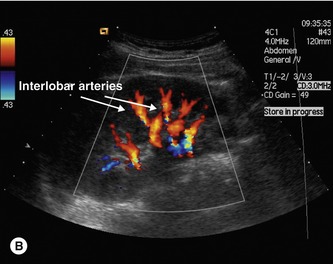

EDV, end diastolic velocity RI, resistive index SV, peak systolic velocity. The measurement calipers are then set at the systolic peak (white open arrow) and end diastole (black open arrow) of a waveform, and the RI is calculated according to the formula (PSV-EDV)/PSV. A sample volume (arrow) is placed within an intrarenal artery (an arcuate or interlobar one) under Color Doppler guidance and spectral analysis of vascular signals is obtained. In order to maximize waveform size, care should be taken in using the lowest pulse repetition frequency without aliasing, the highest possible gain without noise and the lowest wall filter. An RRI value 0.60 ± 0.01 (mean ± SD) is usually taken as normal with a value of 0.70 being considered the upper normal threshold by most authors.

An RRI is calculated with the following formula: (peak systolic velocity – end diastolic velocity)/peak systolic velocity, and the mean value of three measurements at each kidney is usually considered. Measurements should preferentially be repeated in different parts of both organs (superior, median, and lower) when at least three reproducible waveforms have been obtained.

As resistance to blood flow progressively increases from the hilar arteries toward the more peripheral parenchymal vessels, it is generally recommended that sampling for RRI should be done at the level of the arcuate or interlobar arteries, adjacent to medullary pyramids ( Fig. A high frequency probe is recommended together with the use of color or power Doppler to help vessel localization. The need for meticulous, standardized techniques to obtain Doppler signals has been repeatedly emphasized. This article will briefly review the main clinical applications of RRI and will discuss more recent data on its meaning and prognostic usefulness in the management of patients with hypertension. Recent clinical and experimental evidence indicates that an increased RRI in patients with primary hypertension not only reflects changes in intrarenal perfusion, but that it is also associated with systemic hemodynamics and atherosclerosis, and may provide useful prognostic information and possibly have therapeutic implications. Indeed, the Doppler-derived renal resistive index (RRI) has been used for years in a variety of clinical settings such as the assessment of chronic renal allograft rejection, detection and management of renal artery stenosis, evaluation of progression risk in chronic kidney disease (CKD), differential diagnosis in acute and chronic obstructive renal disease, and more recently as a predictor of renal and overall outcome in the critically ill patient. Doppler-derived indexes may thus reflect one or more pathogenetic mechanisms such as arteriolosclerosis and interstitial fibrosis, which contribute to determining vascular distensibility. Evaluation of vascular impedance at different sites of the renal parenchyma may suggest functional or structural changes within the kidneys and could provide useful diagnostic and prognostic information.Īlthough the functional and structural factors that contribute to renal blood flow patterns and changes are still not completely understood, intraparenchymal arterial waveform is believed to be the result of both vascular compliance and resistance. Not only does Doppler ultrasonography detect renal macroscopic vascular abnormalities but it also identifies changes in blood flow at the microvascular level. Ultrasound and Doppler imaging has also traditionally been used in the assessment of chronic renal disease. Looking for renal abnormalities such as increased albuminuria or mild reduction in glomerular filtration rate (GFR) has been proposed with growing emphasis as the initial step in the evaluation of cardiovascular risk, also thanks to its relatively low cost and feasibility. Detection of target organ damage plays a key role in the evaluation of overall risk, and therefore in the management of patients with primary hypertension.


 0 kommentar(er)
0 kommentar(er)
